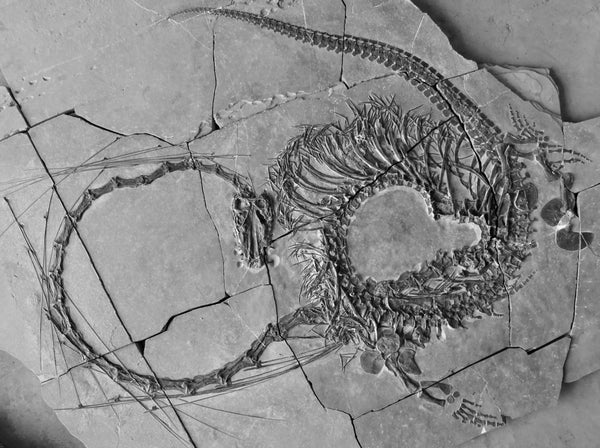Around 240 million years ago a serpentlike reptile named Dinocephalosaurus ruled the waters of what is now southern China. Boasting a toothy maw and an elongated neck of mythic proportions, this prehistoric predator could easily be confused for the legendary dragons found throughout Chinese mythology.
So it’s fitting that a team of researchers recently described several remarkable Dinocephalosaurus specimens just weeks after the Year of the Dragon began. One of those fossils, found coiled in a dramatic pose, is the most complete example to date of the slender reptile.
“It’s wrapped in this figure eight, which looks a bit like that mythical Chinese dragon,” says Nicholas Fraser, a paleontologist at the National Museums Scotland and a co-author of the new paper, published last week in the journal Earth and Environmental Science Transactions of the Royal Society of Edinburgh.
On supporting science journalism
If you're enjoying this article, consider supporting our award-winning journalism by subscribing. By purchasing a subscription you are helping to ensure the future of impactful stories about the discoveries and ideas shaping our world today.
In the new study, Fraser and a group of international researchers analyzed five new Dinocephalosaurus fossils to learn more about how this bizarre animal lived. One of the co-authors, Li Chun, first described Dinocephalosaurus orientalis in 2003 based on a well-preserved skull uncovered in southern China’s Guizhou Province. Since then Li, who is a paleontologist at the Institute of Vertebrate Paleontology and Paleoanthropology of the Chinese Academy of Sciences, uncovered several more complete Dinocephalosaurus specimens from around the region. Rocks containing one set of fossilized Dinocephalosaurus vertebrae were being used by a local farmer to enclose a pig pen.
Together the new fossils reveal just how strange Dinocephalosaurus was. The nearly 20-foot-long ancient reptile resembled a snaggle-toothed sea serpent with a set of short, paddlelike limbs. Its head was perched at the end of a slender neck. “I was excited to see such a long neck,” says Ryosuke Motani, a paleontologist who studies marine reptiles at the University of California, Davis, and was not involved in the new study. “What intrigued me is that the neck is more than twice as long as the body trunk. That is remarkable.”
When Dinocephalosaurus lived, during the middle Triassic period, southern China was covered by balmy coastal waters filled with other seafaring reptiles, including dolphin-shaped, sharp-toothed ichthyosaurs. And Dinocephalosaurus was not the only local marine reptile to stick its neck out. Slightly younger Triassic fossils of the similarly sized Tanystropheus hydroides show that this animal also sported a dramatically elongated neck.
But each of these ancient reptiles appear to have evolved their proportions independently from one another, inspection of the new fossils shows. While Tanystropheus’sslender neck has 13 elongated vertebrae, Dinocephalosaurus’s had 32 shorter ones. “It was the same sort of neck proportions as Tanystropheus but made up in a very different way,” Fraser says.
Despite its many bones, Dinocephalosaurus’s neck would have been quite stiff because those vertebrae were anchored by bundles of riblike bones. Tanystropheus likely had a similarly stiff neck. That’s unlike the more malleable long necks wielded by later plesiosaurs, another group of marine reptiles that lived some 40 million years later during the Jurassic period. But Motani thinks both the stiff and flexible necks still played similar ecological roles. These features likely “set the head far off the main body so as not to scare the prey off with its large body size before getting [within] striking distance,” he says.
Based on Dinocephalosaurus’s wonky proportions, Fraser and his colleagues think the prehistoric predator was fully aquatic. While its neck would have made the animal ungainly on land, it would have been perfectly adapted for ensnaring seafood underwater. The researchers found several fossilized fish lodged inside one of the newly described Dinocephalosaurus skeletons.
Another team of researchers reported the presence of preserved embryos in a Dinocephalosaurus specimen in 2017—further evidence for Dinocephalosaurus’s aquatic lifestyle. It indicated that unlike most reptiles that lay eggs, Dinocephalosaurus appears to have given birth to live young at sea, which helped it avoid waddling onto land, where it risked falling prey to terrestrial predators or being stranded ashore. In the new paper, the researchers found small bones that might be those of an embryo inside one of the newly described specimens.
According to Fraser, releasing the paper right after the Lunar New Year was a coincidence. The paper had been in the works for years, and its scope had repeatedly expanded to include additional Dinocephalosaurus fossils that Li and his team kept finding. But “I think it is vitally important that we do tie these finds to local cultures” where these fossils were found, Fraser says, and the fortuitous timing presents a remarkable opportunity to highlight China’s prehistoric past and natural heritage.
